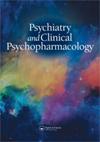第十一届国际精神药理学大会暨第七届儿童与青少年精神药理学国际研讨会
IF 0.5
4区 医学
Q4 PHARMACOLOGY & PHARMACY
引用次数: 43
摘要
非典型抗精神病药(SGA)是首选药物,但这类药物可能导致相对较多的代谢问题。糖尿病酮症酸中毒(DCA)是一种急性、危及生命的糖尿病并发症,可由SGA引起。在这个报告中,我们报告了一位17岁的男性患者,他患有DCA,被认为是由奥氮平治疗引发的。病例介绍:E.在儿童和青少年精神病学门诊随访治疗约6年。他一生中没有吸烟、酗酒或滥用药物的历史。家族中无精神病史。他的阿姨有2型糖尿病病史。他第一次咨询我们是在大约两年前,他抱怨自己易怒,对家人造成伤害,还有睡眠问题。在这次采访中,我们了解到她曾接受利培酮2mg /天的治疗,但没有任何效果。精神状态检查未发现任何轻躁、躁狂、精神病性症状和体征。患者给予阿立哌唑5mg /d治疗,用药效果良好。2.5个月后,患者再次入院,家属抱怨“无法入睡,害怕,咬自己,自言自语”。在检查中测定了厌恶、肮脏强迫症和清洁强迫症、视觉、听觉和听觉幻觉。患者转至儿童神经内科,建议住院治疗。但家属不希望住院治疗,神经系统检查也未发现病理。患者计划给予奥氮平5 mg,每日2次。大约1.5个月后,患者再次入院,他如此烦躁,焦虑,失眠,建议继续奥氮平,早上5毫克,晚上10毫克。治疗第三周,患者以恶心、呕吐、腹痛、意识模糊等症状入住急诊室。在评价中;血糖434 mg/dl,尿糖3+,蛋白2+,酮3+,pH 6.0;血气pH值为7.146,诊断为糖尿病酮症酸中毒,送儿科重症监护病房。停用奥氮平治疗,出院时给予胰岛素治疗。患者仍给予阿立哌唑15mg /d治疗。SGA如何导致高血糖仍不清楚。由于奥氮平的增重作用,增加外周和肝脏胰岛素抵抗和刺激X受体是导致这种影响的最已知因素。这一机制似乎无法解释糖尿病的快速发病。一些使用奥氮平的临床试验显示患者胰岛素分泌有双相变化。奥氮平在治疗早期作用于直接β细胞,胰岛素分泌明显减少可能伴随这种代谢状况。就像我们的病人一样,据说这种可能性在遗传易感性的情况下会增加。应特别注意奥氮平的使用,它可能在有家族易感性的年轻患者中更频繁地引起代谢副作用。本文章由计算机程序翻译,如有差异,请以英文原文为准。
11th International Congress on Psychopharmacology & 7th International Symposium on Child and Adolescent Psychopharmacology
Atypical antipsychotics (SGA) are used as first choice but this group of drugs may cause relatively more metabolic problems. Diabetic ketoacidosis (DCA) known as an acute, life-threatening complication of diabetes, can be triggered by use of SGA. In this presentation, we present a 17year-old male patient who had DCA that thought to be triggered by olanzapine treatment. Case presentation: E. has been followed up and treated for about 6 years in child and adolescent psychiatry outpatient clinic. He had no history of smoking, alcohol or substance abuse in any period of his life. There was no history of psychiatric disease in the family. His aunt has a history of type 2 diabetes. The first time he consulted us was about 2 years agowith the complaint of irritability, harm to his family and sleep problems. In this interview, we learned that she had been treated with risperidone 2 mg/day but had no benefit. Mental status examination revealed any hypomanic, manic, psychotic symptoms and signs. Aripiprazole 5 mg/day treatment was arranged and he benefited from drug. Patient was admitted again after 2.5 months and family had complaints of “inability to sleep, fears, biting himself, talking to himself”. Avolition, dirtiness obsessions and cleaning compulsions, visual, auditory and auditory hallucinations were determined in the examination. Patient was referred to child neurology and psychiatric hospitalization was recommended. However family did not want hospitalization and no pathology was found in her neurological examination. Patient was planned to have olanzapine 5 mg, 2 times a day. Approximately 1.5 months later, the patient re-admitted to us, he was so irritable, anxious, unsleeping and suggested to continuation of olanzapine in morning 5 mg and evening 10 mg. In third week of treatment, patient was admitted to the emergency room with nausea, vomiting, abdominal pain and blurred consciousness. In the evaluation; blood glucose 434 mg/dl, urine glucose 3+, protein 2+, ketone 3+, pH 6.0; The blood gas pH was found to be 7.146 and it was accepted to the pediatric intensive care unit with diagnosis of diabetic ketoacidosis. Olanzapine treatment was discontinued and he was discharged with insulin therapy. The patient is still followed up with aripiprazole 15 mg/day treatment. How SGA lead to hyperglycemia remains unclear. Due to the weight gain effects of olanzapine, increasing peripheral and hepatic insulin resistance and stimulating X receptor are most known factors contributing to this effect. This mechanism does not seem possible to explain the rapid onset of diabetes. Some clinical trials with olanzapine have shown biphasic changes in insulin secretion in patients. Olanzapine acts on direct beta cells in the early period of treatment and that insulin secretion decreases significantly may accompany this metabolic condition. As in our patient, it is stated that this possibility increases in case of genetic predisposition. Particular attention should be paid to use of olanzapine, which may cause metabolic side effects more frequently in young patients with familial predisposition.
求助全文
通过发布文献求助,成功后即可免费获取论文全文。
去求助
来源期刊

Psychiatry and Clinical Psychopharmacology
Medicine-Psychiatry and Mental Health
CiteScore
1.00
自引率
14.30%
发文量
0
期刊介绍:
Psychiatry and Clinical Psychopharmacology aims to reach a national and international audience and will accept submissions from authors worldwide. It gives high priority to original studies of interest to clinicians and scientists in applied and basic neurosciences and related disciplines. Psychiatry and Clinical Psychopharmacology publishes high quality research targeted to specialists, residents and scientists in psychiatry, psychology, neurology, pharmacology, molecular biology, genetics, physiology, neurochemistry, and related sciences.
 求助内容:
求助内容: 应助结果提醒方式:
应助结果提醒方式:


